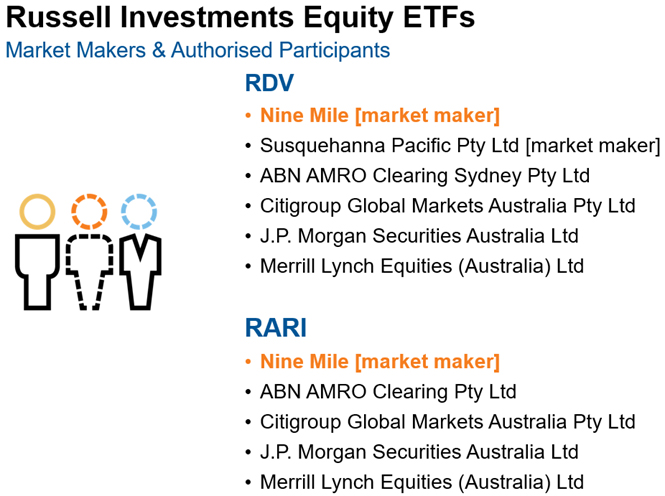ETF Market Making – how and when to trade ETFs efficiently
The Australian ETF market continues to attract record inflows, surpassing $122bn as at end August 2021. For investors buying and selling ETFs trading at the ‘right price’ has never been more important. We take a look at ‘a day in the life of an ETF market maker’ and provide investors that buy and sell ETFs some helpful insights on how to trade them efficiently.
Market Makers (MMs) & Authorised Participants (APs)
Investors can buy and sell ETFs on the Australian Stock Exchange (ASX), just like they do individual shares – but for the ETF market to operate efficiently, we rely on market markets (and APs). Investment banks and specialist trading firms fill this role, and in Australia, it remains a relatively concentrated list of firms. MMs are (contractually) obligated to show bid and offer prices in a particular ETF throughout the trading day, whereas APs can be active in an ETF whenever they choose.
An ETF listed on the ASX must have at least one MM and will typically have numerous other APs. The arrangement for Russell Investments equity ETFs, Russell Investments High Dividend Australian Shares ETF (RDV) & Russell Investments Australian Responsible Investment ETF (RARI), is shown below:
As can be seen from above, Nine Mile is MM for both ETFs and RDV has an additional MM in Susquehanna. In addition, multiple trading firms act as APs which helps ensure that bid/offer spreads in both ETFs are tight and thus attractive for buying and selling RDV/RARI. This gives investors comfort that they are trading the ETF at a price that reflects the valuation of the underlying holdings. Another check for investors is to see how the screen prices compare to the ETF ‘iNAV’ (indicative net asset value) – this will normally be somewhere in between the bid and offer price.
ASX trading session – what this means for trading ETFs
Despite the ETF market normally operating efficiently, Australia is not without its quirks. The ASX still has a staggered open from 10am – where stocks fall into one of five alphabetical ‘opening groups’. For example, Telstra begins trading 9 minutes later than ANZ or BHP. This has implications for ETFs too – they cannot be priced accurately until all stocks in an ETF ‘index’ have started trading. Hence, it is sensible to wait until 10:20-10:30am before trading ETFs, by which time all Australian stocks are well into their trading day and, as a result, ETF prices from MMs/APs will have the have their tightest bid/offer spreads.
When we approach 4pm and market close, this is another time ETF investors need to be wary. Market makers will normally need to widen their prices as we approach the closing auction – given the uncertainty on where all the underlying stocks in an ETF will finish the day. Therefore, it is wise to stop trading ETFs several minutes BEFORE the 4pm match process – to ensure ETFs are being traded whilst bid/offer spreads remain tight.
Finally, it is worth noting that both MMs and APs can trade at the closing NAV (net asset value) in institutional sized ETF orders (typically $1m+) which avoids any spread related trading costs.

‘A day in the Life of an ETF Market Maker’
The next section summarises a quick-fire Q&A session with our ETF Market Maker, Nine Mile, to better understand what is involved in pricing and trading ETFs on the ASX. Nine Mile Financial (NMF) is a registered market maker and liquidity provider for currently 160 (and growing) of the 224 ETFs listed on the ASX.
1. What does NMF do?
As the appointed market-maker on the Russell Investments ETFs, it’s NMF’s job to ensure that investors wanting to buy and sell the Russell Investments ETFs are able to do so on the ASX. As a liquidity provider, NMF helps maintain and improve the overall transparency and efficiency of ETFs by quoting bid and ask prices. By providing liquidity, NMF make it easier for investors to buy and sell ETFs at a price that reflects the current price of the underlying assets. It’s essential that NMF does this consistently during the ASX operating hours to ensure the efficient operation of the ETF market.
2. How does NMF decide the prices?
Each ETF typically has a number of instruments in its portfolio. NMF must understand, in real-time, the value of these instruments to be able to price the ETF accurately. on each of the underlying instruments to be able to accurately price the ETF. NMF does this by consuming data on the underlying instruments of the ETFs and applying its sophisticated pricing models. NMF utilises state of the art technology and enormous datasets, to quickly calculate and produce a fair value for each ETF it trades. This is done in microseconds, billions of times a day.
3. How many security prices do you monitor through the day to make markets in 160 ETFs on the ASX?
NMF utilises hundreds of thousands of security prices from all global exchanges. Consuming this global data requires a resilient high speed global network, along with sophisticated algorithms to accurately and quickly process the information. The NMF trading day runs 24hours – as one exchange closes another opens, making our trading day non typical. In Sydney our day starts early, initially collecting trades that have been done in the European and US trading hours and connecting with the ETF issuers, like Russell Investments, to consume the underlying portfolios that make up each ETF. This information is loaded (automatically) into our trading systems to allow us to accurately price all ETFs once the ASX trading session has fully opened.
4. What are the biggest challenges for you?
Volatile markets, like those this month due to iron ore price weakness and the ongoing Evergrande concerns that can spook markets leading to bigger and quicker price changes. For us to stay on top of what the ‘fair value’ is for the ETFs we quote, we rely on robust technology infrastructure that can process price changes across many thousands of securities in microseconds. This ensures the prices we are making in the ETFs remain accurate at all times.
5. What advice can you offer to individual investors and financial advisers?
ETFs are increasing in popularity due to their low-cost, diversified nature, and are seen to be a perfect building block from which to build a diversified portfolio of investments. ETFs provide access to world class asset managers, such as Russell Investments, whom produce a number of different ETFs for investors to choose from – further allowing investors to increase diversification across all asset classes. Whilst some ETFs are more successful than others, we would encourage investors to invest in instruments that fit within their risk tolerance. Asset managers such as Russell Investments are always available to help inform investors about their products and importantly the differences between them – arming investors with the right information to allow them to make an informed decision.
(Disclaimer: noting any information provided would be general information only and not financial product advice. Any investor should seek their own advice and read the PDS before investing)
6. Any clear trends you are seeing in the ETF market on the ASX recently?
The most obvious trend is the very strong interest in ESG products, along with a general move towards listed product offerings (actively managed funds being listed as an exchange traded product). We expect to see the number of ETFs we market make continue to grow as investment firms launch new products to capture investor appetite for both passive and active style ETFs.
